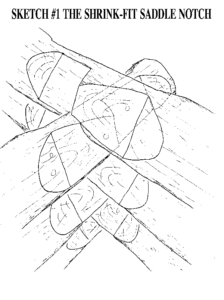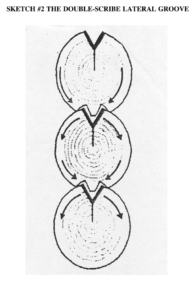

To the average log home purchaser trying to understand why there are so many different forms of log construction joinery and which is best for what reasons are a mystery. This article will deal with full scribe joinery but the principals apply to all forms of log joinery, even manufactured log construction.
Lets start with some basic understandings. Logs – wood is a by-product of living things, trees. Non living wood by its nature will always attempt to equalize its moisture content with the air it is in contact with. This applies to wood even thousands of years old! If a manufacturer of log homes claims that their logs will not “shrink”, warp, twist, crack or settle, this will only be true if their logs are made of something other than wood. That’s not to say that these characteristics can not be controlled or in some ways used to a benefit but it is impossible in log construction not to be effected by the drying out or swelling up of wood. It is something true craftsmen have dealt with for all of history.
Log construction began thousands of years ago probably in more northern climates where large forests were close at hand. The reasons then and now for using logs as a building material is that they can provide the best quality shelter in more drastic climates. Today aesthetics probably plays an equal perhaps more important role in people choosing logs as a construction material.
Using logs for shelter implies that logs will become a barrier between temperatures of different levels of comfort. This creates one of the most important challenges for log joinery. If the joinery is to create a barrier between inside and outside as well as the logs both must react to different conditions meaning different temperatures and different air moisture levels. Lets look at the scenario of winter. Cold normally more humid air outside and warmer drier air inside. Unless we do something to change the humidity level inside this will always be the case. Warmer drier air inside means more and faster drying of logs that are in contact with that air than logs in contact with the outside colder more humid air. When we use logs as a barrier to those differences that means our perimeter wall logs are going to be exposed to different conditions at the same time. Each of our perimeter wall logs on the inside will want to dry out faster and somewhat more so than that same log does on the half exposed to the outside.
So why not just use much drier logs to begin with? Much drier logs will have developed uncontrolled checks, the longitudinal cracks, according to how much they have already dried. Each check that crosses your joinery is an air leak. It is somewhere between virtually impossible and impossible to caulk or chink every existing check in a pre-dried log that can potentially be an air leak. The finest method of full scribe joinery done on logs prior to checking will 100% of the time control checking that could potentially create and air leak in the longitudinal joinery in the walls. After all, fully scribed joinery implies you should not need to caulk or chink that log wall ever. Fully scribed joinery is an expression of craftsmanship similar to craftsmanship in furniture. Would you consider furniture to be finely crafted if all the joinery was filled with putty?
So our logs, once they are heated will continue for normally around 3-5 years to loose moisture until they reach an equilibrium with their average annual surroundings’ humidity level. From then on they will take on a little humidity during damper times of the year and give off a little during drier times to eternity.
What is settling? Settling is comprised of two factors – shrinkage and compression. For simplicity sake I will say each comprises of about 50% to make up settling. This varies slightly between species of trees. Shrinkage, the loss of dimension in a radial direction and also by circumference, is the challenge for log joinery. Compression caused by loads bearing weight down onto a given log and its joinery can be of great benefit to keeping joinery tight. We’ll start with the most basic notch, the round notch. Often this notch is improperly labelled a saddle notch. Imagine an intersecting corner of two perpendicular horizontally stacked log walls that are ½ layer different in height. If no shaping of the logs in the corner was done the contour of the upper half of a log would be matched by a notch cut out of the underside half of the next intersecting log above. The approximate shape of that notch would be an arch. Since logs do not appreciably shrink lengthwise, down the longitudinal axis of the log, the sides of the arch will not change in width but the arch will shrink in height. The perpendicular sides of the log that the notch was cut for will also shrink in diameter.
Simply put, the notch will become looser the closer it approaches vertical because of the shrinkage in diameter of the log it covers.
The saddle notch is a notch that is cut to fit a reshaped log where the vertical sides have been carved back to create two consistent planes of approximately 45 degrees. The saddle notch without compression from above, after shrinkage, will have a consistent gap half that of the vertical sides of a round notch. If we add a crushing weight, compression, from above we could squeeze the joint back together, because the consistent plane of the reshaped log and notch cut to match will reunite if enough downward pressure could be created. What could normally prevent this? If the longitudinal wall log joinery (the Swedish cope or double scribe) bears too much weight along the horizontally stacked logs the notch will not come back together. This is the principal that no doubt, caused the (re-) development of Del Radomske’s over-scribing. In over-scribing the longitudinal groove is scribed and cut to different setting than the notch in the same log. The result at the time of initial construction is that the notch bears all the weight of the log it is cut out of. The longitudinal groove remains, for a period of time, parallel and directly above the log it was scribed to until sufficient compression and or shrinkage in the notch occurs and allows the longitudinal groove to contact the log it was cut for. Today all the premier full scribe handcrafters are using this technique to aid in insuring tighter fitting homes.
The dovetail notch is a notch requiring compression to keep its sloping planes fitting tight, however the vertical sides as with the round notch will always be detrimentally effected by shrinkage.
 The only known notch that can achieve a benefit from shrinkage is the true shrink-fit saddle notch. Often builders improperly name their regular saddle notch as a shrink-fit saddle notch. A true shrink-fit saddle notch must force the notch to climb a wedge shaped plane during the shrinkage of the notch. This wedge shaped plane is orientated horizontally on the lower log of the two intersecting logs with the heel of the wedge located at the longitudinal centerline of the perpendicular log wall. (See sketch #1 right) I believe the wedge is only of significant benefit in the areas most effected by shrinkage, the sides orientated inward to the heated part of the home.
The only known notch that can achieve a benefit from shrinkage is the true shrink-fit saddle notch. Often builders improperly name their regular saddle notch as a shrink-fit saddle notch. A true shrink-fit saddle notch must force the notch to climb a wedge shaped plane during the shrinkage of the notch. This wedge shaped plane is orientated horizontally on the lower log of the two intersecting logs with the heel of the wedge located at the longitudinal centerline of the perpendicular log wall. (See sketch #1 right) I believe the wedge is only of significant benefit in the areas most effected by shrinkage, the sides orientated inward to the heated part of the home.
To summarize, notches that have visually exposed vertical sides will shrink open. Notches cut to match a reshaped log where the sides of lower log are on an approximate 45-degree plane will fit after shrinkage if enough downward compression can be applied. A shrink-fit notch must be cut to match a sloping plane that also has on a perpendicular direction a wedge that forces the notch to climb the wedge during shrinkage.
On a different note the Norwegian notch, which has the logs as they approach a corner, reshaped into a diamond shape of 4 approximate 45-degree sloping saddles is largely done for aesthetic reasons. The lower saddles that create the diamond effect do not benefit or diminish the fit of the notch when compared to the results of the normal saddle notch. Those lower diamond saddles would however reduce the
benefits created if they were applied to a shrink-fit saddle notch, by reducing the amount of climb created by shrinkage along the wedge.
The longitudinal groove depending on its profile is normally termed either the Swedish cope – Scandinavian full scribe or the double scribe. A very simple rule applies to these longitudinal grooves. The more wood that is removed on the underside of the log the worse the fit after shrinkage. All longitudinal cuts on a log will, during shrinkage, promote spreading of the log fibres by checking. A deeply cut groove on the lower side of the log such as used by high production companies has consistent worse fits after shrinkage than does a shallow cut Swedish cope that only bears weight on the outer edges. A double scribe groove takes this direction one major step further. It is the minimum possible amount of wood removed from the underside of a log plus on the top side of the lower log a groove is cut to allow wood left between the scribed edges of the upper log a place to go. (see sketch #2 left)

By cutting a “V” groove out of the inside of the scribed fit we also eliminate 100% of the time a check from developing on the lower log that would cross the scribed fit.
By minimizing the wood removed on the underside and then removing that amount plus more of wood from the upper side of the lower log causes the majority of the checking to occur in the center
of the “V” groove. Now the checking spreading action exerts pressure against the edges of the scribe above. In a deeply cut Swedish – Scandinavian groove the checking causes spreading away from the fit, creating gaps in the joinery. The easiest way to test the validity of this
understanding is to compare fully settled homes (about 5yrs old) of various builders and the long term effects of their different joineries. Keep in mind, the drier the climate the homes are in, the more evident the differences in quality will be.
Lloyd Beckedorf
Moose Mountain Log Homes Inc. Jan/99
#46 Griffin Industrial Point
Cochrane, AB
T4C 0A3